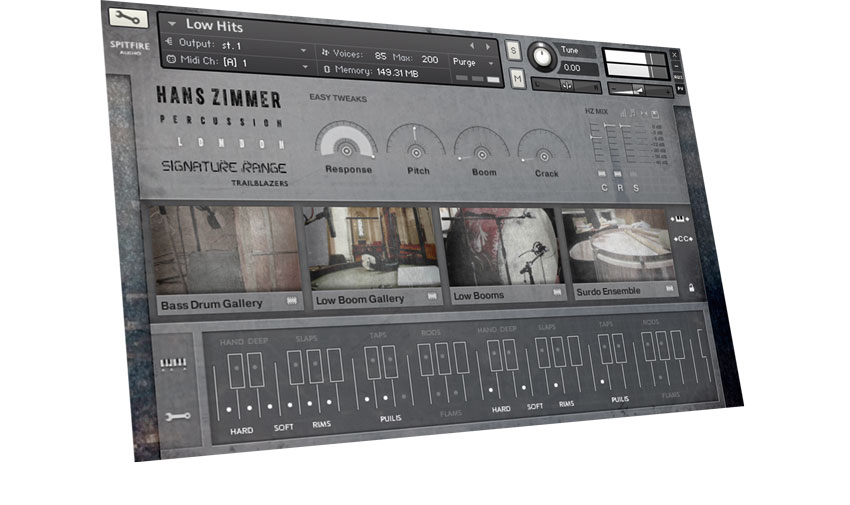MusicRadar Verdict
Huge-sounding, versatile and packed with the 'HZ Factor', this is a truly epic percussion library.
Pros
- +
A staggeringly dynamic, generously-appointed, lovingly recorded percussion library. A wide range of microphone choices lets you personalise your sound. Revised Spitfire GUI provides easy yet great-sounding tweaks.
Cons
- -
Price.
MusicRadar's got your back
Since the release of its first Kontakt-powered collection, Albion, this writer has taken great interest in the development of Spitfire Audio's range of sample libraries.
Since then, more orchestral section libraries, solo instruments and smaller chamber libraries have followed, notwithstanding Spitfire's Percussion Redux library which offers a comprehensive and well-recorded collection of 'standard' orchestral percussion instruments.
Spitfire Audio now returns with a new library of percussive sources as part of the Signature range. As collaborators go, it has set the bar at the top for this release, as the project has been jointly overseen by Hans Zimmer.
So Hans' engineers and chosen session players have been hand-picked to record the library's sounds at Air Studios. As such, the library forms the London collection (HZ01), with a Los Angeles equivalent to follow.
Download and GUI tweaks
Once downloaded, the core library runs to 54GB of content and, once activated via NI's Service Centre, you'll find that it's organised into three main folders. These provide mix configurations as chosen by Hans Zimmer and two of his trusted engineers - Alan Meyerson and Geoff Foster, with more engineer configurations due in future.
"The exhaustive recording sessions included multiple microphone set-ups to provide the broadest range of recordings possible"
The reason that separate mixes are available is that the exhaustive recording sessions included multiple microphone set-ups to provide the broadest range of recordings possible and, as you might expect, different sets of expert ears would choose to balance that raw sample material differently.
Accordingly, each folder provides access to the same sound sources but each sculpts a different balance from the available microphones. These provide Close, Room (mid-distance) and Surround (far) options and, as per other Spitfire libraries, you can blend all three of these microphones in any volume configuration you choose.
A separate download supplies additional microphone content, with dedicated programs letting you access these. The additional mic arrangements are Tree, Bottle, Mid-Field, Gallery, Overheads, Pair and Piezo Tree, so if the main patches don't provide the sound you're after, there are plenty of other options. You'll need an extra 29GB of hard drive space for the additional microphone content (at no further cost, of course), swelling the library to 83GB.
The GUI is different to past Spitfire releases in other regards, too. You'll find a series of semi-circular controls at the top; these are designed to perform quick, easy tweaks. Response comes first, letting you compress the dynamic range of the samples.
This is extremely useful as some of the drums progress from a 'barely there' tap to a cacophonous smack, so being able to temper this range from within the library itself is often essential. Pitch lets you detune things dramatically, with extreme settings pushing the drums into sound design territory. Finally, Boom and Crack dials provide filtering; low-pass and high-pass respectively.
Beat me up
"Hans Zimmer is famous for bombastic percussive writing through his scores and this library captures his techniques beautifully"
Thereafter, it's all about the instruments. Hans Zimmer is famous for bombastic percussive writing through his scores and this library captures his techniques beautifully. You can either load programs which access multiple sound sources (which can be individually loaded/ unloaded via keyswitches) at once, or pick individual programs to focus on a single Ensemble.
The bottom of the GUI then loads a keyboard graphic to show you which keys are active, with the playing style, stick type, beater choice or technique arranged across the keyboard. These are uniform through the library, so the Hard beater hits are always assigned to C1 and D1, for instance, ensuring that you don't have to learn new key positions for each program.
Most programs are Ensembles, marrying complementary groups of sounds together, and these are organised into Bucket Hits, Exotic Hits, Low Hits, Metal Hits, Timpani Hits and Taiko Hits. This final Ensemble group is the only one which provides access to individual drums, with Hi, Low and Large programs available alongside the Ensemble patch which combines all three.
This might sound limiting, yet the sheer range of combinations, accessible via keyswitches and hugely complemented by the tonal and timbral differences afforded by the microphone choices, means in practice it's easy to find, program and blend programs to your track. And, despite its size, this is one of the easiest libraries to navigate and integrate into a project that I've come across.
Hans' success as a composer will provoke two reactions. Some will love to get in on his signature explosive sonic action and this library will fast-forward them to that place. But some will feel his sound is unique to him and should be avoided in a bid to carve out a more personalised voice.
If you fall into the latter category, don't be put off - there's so much flexibility that, at its core, HZ01 is ready to be, percussively, whatever you want it to be.
“We were arguing a lot and we were miserable”: How Green Day exceeded expectations with their most ambitious song
"There’s plenty for us guitarists to learn – and ‘less is more’ is the overriding lesson": how to play like George Harrison on The Beatles' Abbey Road
“They didn’t like Prince’s bikini underwear”: Prince’s support sets for the The Rolling Stones in 1981 are remembered as disastrous, but guitarist Dez Dickerson says that the the crowd reaction wasn’t as bad as people think










